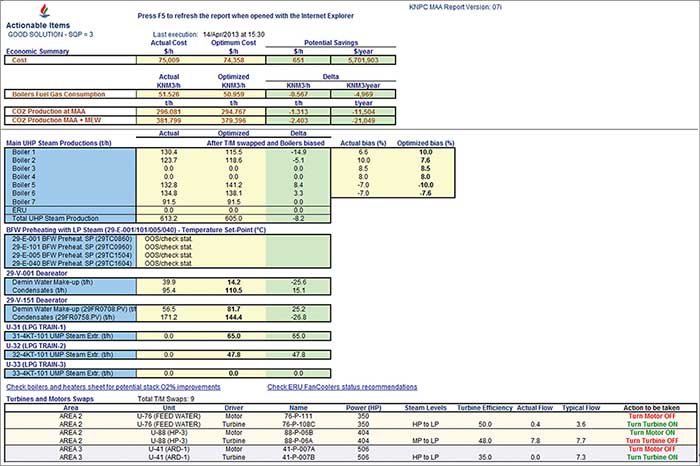Creating a model of a refinery energy system validated with real time data increased energy efficiency and reduced total energy costs
MOHAMMAD ERSHAID, KNPC Mina Al-Ahmadi Refinery
CARLOS RUIZ, DIEGO RUIZ and NICOLÁS VISUARA, Soteica Visual MESA
DHANASEKAR PERIYASAMI, EBS
It is Kuwait Petroleum Company's (KPC) and its subsidiaries' policy to ensure that all energy should be managed in accordance with best engineering environmental practices and within regulatory compliance at all times.1 All operations must be committed to institute an energy efficiency programme and minimise emissions of pollutants including global warming gases. As part of the activities to follow those premises, energy management cells (EMC) have been formed at each of the Kuwait National Petroleum Company (KNPC) refineries: Mina Al-Ahmadi (MAA), Shuaiba (SHU) and Mina Abdulla (MAB). Such cells implemented an energy management programme based on best international practices and on real time, online optimisation.
This article describes the tasks performed to develop and implement a real time, online model for energy cost minimisation and energy management at KNPC's MAA refinery.
After a description of the main project implementation tasks, the Real Time Energy Management System's (RTEMS) functionalities are described and the optimisation implementation procedures are commented on. Finally, several obtained results are presented.
Project implementation tasks
The main stages of the project have been:
- Define and installation stage
- Model building and configuration stage
- Training stage
- Site acceptance stage
- Commissioning stage.
Define and installation stage
The first stage of the project includes the tasks of data collection, control system review, software installation and detailed definition of the model scope. Data collection consists basically of gathering system diagrams, real time database tags and equipment information, plus price related information.
The control system review's main goals are: to develop a good understanding of how model optimisation handles and process constraints are related through the site control system; and to identify any new control strategies or changes to existing strategies that are needed to implement the optimisation. As a result of such a review, there is an alignment of the model with the real plant, making sure that suggestions for optimisation can be properly implemented using the site's operating procedures, control strategies and control structure.
Software installation is done on a computer server, accessing the historian data via a standard OPC DA/HDA interface. Software installation at PC clients is also designed for client server access to the model and to facilitate working with the model in standalone mode.
During this stage, a document is prepared and approved with a detailed scope of the model to be implemented.
Model building and configuration stage
A detailed model of the steam, fuels, electricity, emissions, boiler feed water and condensate systems has been built, including all interactions among these systems, real plant constraints and degrees of freedom of their operation. Other utility systems have also been modelled for monitoring purposes such as air, nitrogen, flaring system, cooling water, sea water and hydrogen networks.
Such a model is scheduled to perform automatic executions for the optimisation of the entire system and is continually populated with validated, live plant data. Figure 1 shows a screenshot general view of MAA refinery's RTEMS model graphical user interface.
The main optimisation handles of the energy system are:
- Steam production at boilers
- Fuel gas/fuel oil to the fired boilers
- Pump swaps (steam turbines/ electrical motors switches)
- 81 T-M possible switches above 100 HP; the steam turbines take and discharge steam at different pressure levels
- 17 T-M possible switches below 100 HP; the steam turbines work from UMP/MP to LP steam pressure levels - Condensing turbines
- Extraction-condensing turbines, UHP (ultra high pressure) to UMP (ultra medium pressure) and/or condensate
- Electricity importation
- Natural gas make-up to the fuel gas system
- Steam letdown, excess condensing and vents
- De-aerator water make-up preheating with low pressure (LP) steam.
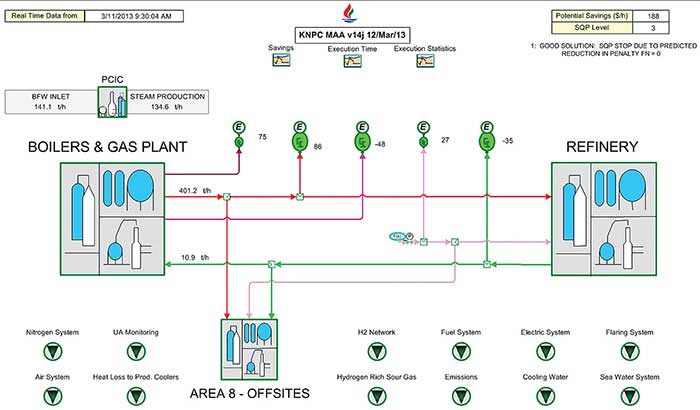
Figure 1 Graphical user interface of RTEMS model, general view for KNPC MAA refinery
The main constraints to be met are:
- Process energy demand
- Burners capacities
- Emissions limits (NOx/SO2)
- Contractual constraints (for instance, natural gas and electricity supply contracts)
- Maximum and minimum operating limits for boilers.
Overall optimisation problem figures are:
- 180 optimisation variables
- 44 continuous variables
- 136 discrete variables
- 64 constraints.
Recommendations given by the model are taken into account by operations on a daily basis. The same model used for the online, real time optimisation is also used in standalone mode, populated either with current or historical data, to perform case studies for planning, or to evaluate alternatives for better operation of the energy system.
Training stage
A mid-point review is carried out to review the model and optimisation with users; at this time, the users' training takes place. A burn-in period corresponds to a fine tuning of the model, operating report and optimisation based on operations feedback in order to achieve day-to-day use of the application.
Operators usually receive a set of recommendations through a custom report. Figure 2 shows an example of such a report. The EMC group contacts the shift supervisor every day for coordination and to follow up changes.
Figure 2 Custom report example with RTEMS optimisation recommendations
Site acceptance stage
This stage corresponds to the site acceptance test, a check-list review of the functionalities required by the RTEMS.
Commissioning stage
During this stage, a full document is prepared and delivered with all details of the implemented system, including troubleshooting and maintenance procedures. Benefits already obtained are also analysed and reported. After commissioning, the sustainability period begins with the main objective of sustaining the benefits.
RTEMS functionalities
The RTEMS has three main capabilities:
- Real time optimisation
- What-if planning
- Auditing and monitoring.
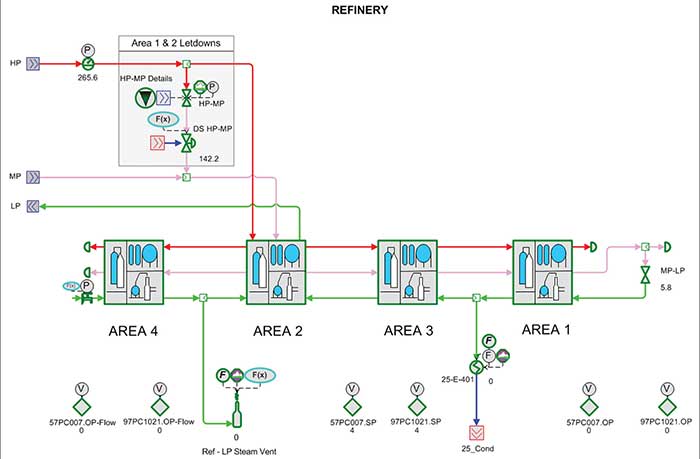
Figure 3 Example of an execution of the RTEMS optimisation in standalone, displaying the optimised results
Real time optimisation
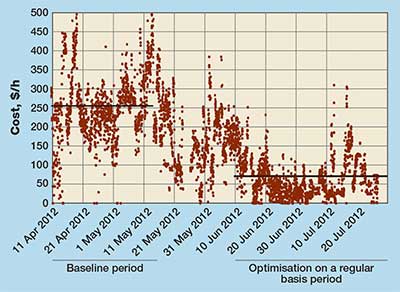 |
| Figure 4 RTEMS optimisation potential savings during Visual MESA project implementation |
One of the main objectives of the programme is to operate the energy system at minimum cost, taking into account all available resources and real operational constraints.2 Since the energy system is highly non-linear and includes continuous and discrete optimisation variables, it requires a mixed integer, non-linear optimisation technique.
The calculation core of the system is MESA (Modular Energy System Analyzer). For the solution of continuous non-linear optimisation problems, MESA employs an implementation of the Sequential Quadratic Programming (SQP) algorithm, developed by Dr Leon Lasdon.3 Lasdon's SQP solver has been fine-tuned specifically for the characteristics of energy system optimisation with particular emphasis on robustness and speed. MESA uses a technique loosely based on 'relax and cut' to deal with mixed integer, non-linear optimisation problems resulting from the start/stop decision of equipment. In this technique, all integer decisions are converted to continuous variables by relaxing the bounds of the associated variables. This reduces the problem to a non-linear continuous optimisation problem that can be solved using Lasdon's SQP. This method has been extensively adapted to suit the characteristics of steam, fuel and power optimisation on a real time basis, especially taking into consideration the time it would take to solve the mixed integer problem.
The objective function to be minimised is the total energy cost which is calculated as:
FuelCosts + PowerCosts + OtherCosts
Under FuelCosts the following costs are included in the different refinery energy systems models:
- Natural gas cost
- Fuel oil cost
- LPG cost.
Under PowerCosts the following costs are included in the different refinery energy systems models:
- Purchased electricity cost
- Export electricity cost.
Under OtherCosts the following costs are included in the different refinery energy systems models:
- Cooling water, sea water, distillate and fresh water costs.
The following example corresponds to a case of real time optimisation at MAA refinery. The set of optimisation recommendations in this case were:
- •Steam production ratio among boilers
- Pump swaps (swappable turbines and motors in different plant areas).
A screenshot from the RTEMS graphical user interface, corresponding to the execution of a stand-alone optimisation, is shown in Figure 3. The hexagonal blocks with mountain icons inside are optimiser blocks. Such items are used to define and configure optimisation variables or degrees of freedom linked to the corresponding equipment. Furthermore, when the hexagonal blocks are coloured inside, they indicate that the optimisers are at a limit; this is a means to highlight visually the constraints the optimisation is hitting during a given optimisation case. In this particular case, optimiser blocks are tied to the low pressure steam vent (LP Steam Vent) and to the low pressure steam condensate (25-E- 401). In Figure 3, both blocks have a red background because they are at the limit during optimisation; that is, both will be completely closed as a consequence of applying the calculated optimisation actions.
As the optimisation results begin to be applied, the potential benefit is reduced, meaning that the over- all utilities system is being operated at a higher efficiency and with lower costs. Figure 4 illustrates the variation of potential savings that could be obtained from the real time optimisation of the KNPC MAA refinery from 11 April to 25 July 2012. Three different periods are shown: base line period, commissioning period and optimisation applied on a regular basis period.

Figure 5 New STG is added; case study example
What-if planning
 |
| Figure 6 Customised report optimisation summary; case study example |
Using the model in standalone mode helps to evaluate potential capital or operating changes to the complex and to assess the economics and operability of such changes.
During a what-if study, an actual site status (as well as the corresponding calculated optimum) can be compared with the optimum case study and easily analysed to show how this change impacts on the site and how to operate the energy system after that change. All imbalances are maintained constant and steam production is allocated to the new demand/ request's proposed scenario.
An example of these kinds of studies is as follows. This study evaluated the impact of installing a new steam turbo generator (STG) unit to provide power to the site and to reduce the UHP-HP steam letdown on the utilities system. The STG includes a back pressure turbine operating within ultra high pressure (UHP) and high pressure (HP) steam levels. In this case, 5.3 t/h more of UHP steam needs to be generated in the boilers and a reduction of 195.1 t/h in the UHP-HP steam letdown can be achieved. The estimated power production is 4.56 MW.
The corresponding effect on the KNPC MAA refinery is a decrease in the steam letdown system and a reduction in the refinery's power imports due to the new power generation. Figures 5 and 6 show the new STG included in a Visual MESA model for what-if case analysis, as well as the customised report summarising and highlighting the results.
Figure 7 Example of boilers efficiencies monitoring report
Figure 8 Example of KPIs report for different units
Auditing and monitoring
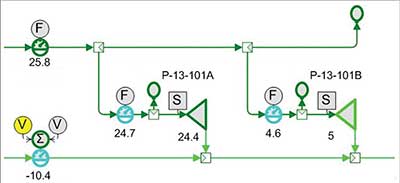 |
| Figure 9 Example of balloons location |
Auditing and monitoring the energy system are important tasks which the RTEMS carries out by helping in the follow-up of key parameters such as equipment efficiencies and energy cost savings, and also in the validation of data.
At every automatic run, the RTEMS calculates and historises:
- Fired boiler efficiencies
- Process heater efficiencies
- Imbalances at every steam pressure level header
- Energy consumption per unit rate for every process unit
- Actual and optimal total energy cost.
The potential gap between the current and actual operating costs and the minimum and optimal operating costs is also calculated and historised. The savings associated with this gap will be materialised only if all the suggested optimisation movements are implemented simultaneously. These predicted savings constitute one of the main economic key performance indicators (KPI). It is expected that, if the operators implement all the proposed recommendations on a continuous basis, the potential gap will start decreasing over time. If in the future the system is in a new condition, a new potential gap will appear until the operators take optimising action and the cycle is repeated. If the projected savings are consistently high, this should prompt management, supervision and/or engineering staff to identify any issue that is impeding the capture of cost reduction.
Another important KPI is related to equipment efficiencies and plant energy costs. Figures 7 and 8 show an example of a customised report for a set of boilers and plants.
The model calculates the incremental cost for fuel burnt. Such a report allows prioritisation of actions to improve combustion based on economic impact.
 |
| Figure 10 RTEMS optimisation implementation procedures |
By auditing the energy system, imbalances can be identified and actions can be taken to reduce it. Therefore, the data can be more and more relied upon to evaluate the value of energy production and usage, and waste can be eliminated.
The methodology is based on getting inaccurate meters fixed because imbalances are inherent to every real world steam system header calculation. The way the RTEMS deals with imbalances is as follows:
- Wherever there is a closed mass, or mass and energy balances, the RTEMS calculates a real time balance offset or bias (the so-called 'balloons', see Figure 9) as the difference between the inlet and outlet streams to/from a given header
- This offset is then held constant for optimisation or case studies (considered as an unmeasured load).
Several actions can be taken based on the magnitude of the imbalance:
- Big imbalances are visually identifiable (the size of the balloon increases and/or the colour dynamically changes)
- Either visually or in a report, the RTEMS will flag these large imbalances to the user who can then focus maintenance attention on the meters associated with that balance.
- If a particularly important sensor fails in the validation test, the RTEMS could automatically shut down optimisers, or force those constraints to which it is related, or even shut down the entire site optimisation.
Optimisation implementation procedures
Operations apply, on a daily basis under EMC supervision, the actions calculated and recommended by the RTEMS in order to minimise the total operating cost, following the implementation procedure shown in Figure 10.
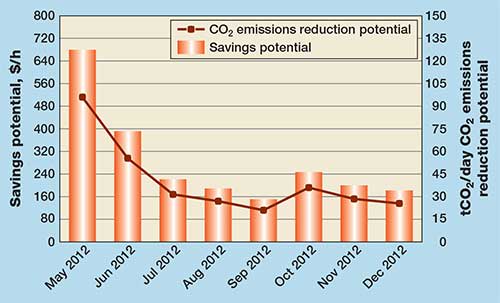
Figure 11 CO2 emissions and economic potential savings, KNPC MAA refinery; their reduction corresponds to captured savings and improvement in the efficiency of the utilities system
Cost savings and CO2 emissions reduction
Figure 11 shows the reported results from one of the refineries (KNPC MAA). The base case was established when the model was completed in May 2012 with an energy cost savings opportunity of about $680/hr. By the end of December 2012, the potential for energy cost savings was reduced to about $180/hr, reflecting obtained savings of about $500/hr ($4.4 million/y).
The cost savings and CO2 emission reductions came from two main sources:
- Reduction of excess steam vent/ condensing (less fuel gas used for high pressure steam production because of the reduction in steam waste)
- Let-down reduction (less power purchase for driving pumps and compressors because of the use of turbines instead of motors).
The estimation basis for reduction of CO2 emissions is shown in Figure 12.

Figure 12 Estimation of CO2 emission reductions as a result of optimisation action
Conclusions
The tasks performed to develop and implement real time, online models, to help with KNPC MAA refinery's energy cost minimisation and energy management and scheduled to perform automatically, have been described. They enable clear identification of the different economic trade-offs that challenge the operation of the site-wide energy systems at minimum cost while reducing energy waste and, therefore, the CO2 footprint. Recommendations given by the optimisers are taken into account by operations on a daily basis.
As a result of the project, information for each refinery energy system has been organised into models and reports to which everyone has access. Having a model of the whole refinery energy system validated with real time data, in one environment that everyone has access to, to understand all the decision variables and the associated constraints, helps coordination among plant areas in order to increase energy efficiency and reduce total energy costs.
References
- KPC HSE Standard Doc-18 (Management of Energy & Resources).
- Use of online energy systems optimization models, Ruiz D, Ruiz C, Book: Energy Management Systems, ISBN 978-953-307-579-2, edited by Giridhar Kini P, Ch4, 85-100. InTech, 2011.
- Experiments with successive quadratic programming algorithms, Fan Y, Sarkar S, Lasdon L, Journal of Optimization Theory and Applications, Vol. 56, No. 3, Mar 1998.
Mohammad Ershaid is Specialist, Process Engineer at Kuwait National Petroleum Company's (KNPC) Mina Al-Ahmadi refinery in Kuwait.
Carlos Ruiz is Energy Management Systems Director with Soteica Visual MESA. He holds a degree in chemical engineering from Universidad Tecnológica and master's and doctor's degrees in chemical engineering from Universidad del Sur, Argentina. Email: carlos.ruiz@soteicavisualmesa.com
Diego Ruiz is Professional Services Director with Soteica Visual MESA. He holds a chemical engineering degree from Universidad Tecnológica Nacional - Facultad Regional Rosario and a doctorate in chemical engineering from Universitat Politècnica de Catalunya.
Nicolás Visuara is a Consultant with Soteica Visual MESA. He holds a degree in chemical engineering from Universidad Nacional del Litoral, Santa Fe, Argentina.
Dhanasekar Periyasamy is Team Leader for Process Modeling and Energy Management with EBS Group WLL, Kuwait.
Related Products & Solutions
-
Process Energy Optimization
- Energy optimization for industrial applications
- Steam, fuel, and electrical power
- Reduces total operational costs while meeting emissions constraints

